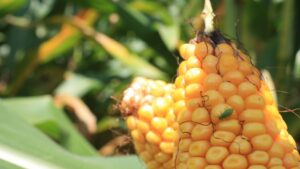Exciting new genetics and cutting-edge technology are rapidly expanding the uses and markets for seed and seed-derived products.
New genetics, technology, ideas in nutrition and markets are continually shaping the crops we grow. The uses of corn and soybeans, along with lesser known crops, are being expanded.
Gordon Selling of the USDA Agricultural Research Service lab in Peoria, Ill., has a matter-of-fact approach to maximizing that value: “A kernel of corn needs to be looked at in the same fashion as a barrel of crude oil. To maximize profits, oil companies use every bit of oil they extract. Similarly, every bit of material present in a kernel of corn needs to be utilized to maximize revenue for the various businesses in the corn product stream.”
A kernel of corn has four main products: starch, oil, protein and fiber. These in turn can be sub-divided into smaller parts, each with unique market values. Selling and his ARS team deal mainly with corn protein, which subdivides into two broad types: corn germ proteins and endosperm proteins. The corn germ proteins have value as a component in adhesives, such as plywood glue. With additional research, future formulations could mean stronger glues and use less non-renewable material.
Soybeans also feature in the ARS agenda at the lab in Peoria, Ill. Zengshe (Kevin) Liu and his colleagues have developed soybean oil-based composites for use in a technique called solid free-form fabrication. This technique is used for making parts or other objects without using molds, and was developed by Paul Calvert at the University of Arizona in Tucson.
Kaichang Li, a researcher at Oregon State University, has discovered that soy can also replace some or all of the formaldehyde resins in plywood, particleboard and fiberboard. Today, interest in soy glue is growing, especially because soy glue is stronger than formaldehyde products and comparable in cost. Through a process called “cross-linking,” Li was able to organize molecules in conjunction with another resin to create an adhesive that was strong enough to withstand degradation in boiling water.
Some manufacturers are experimenting with a combination of soy and formaldehyde adhesives. One company that makes finger-jointed wood products has successfully mixed a 50/50 percent solution of the two glues, which reduces the quantity of formaldehyde used and the amount of outgassing that occurs over the life of the product. Manufacturers have used soy in carpet backing, insulation, and as an additive to paints, stains and strippers. Soy hulls are used for human and animal food products. There is even a WD-40 lubricant in the making, due to soy’s high oil content.
Playing with Plastic
Consumer demand for environmentally-friendly products has given rise to several innovative products. Bio-Plastic Solutions of Blooming Prairie, Minn., is one of the nation’s first to blend corn starch-based polylactic acid with petroleum polymers to make extruded plastic furniture trim, drywall corner bead and interior wall guards. Meanwhile, Vinylite in Fergus Falls, Minn., is developing a soy-based polyoil insulation for window frames.
Nature Works LLC, based in Minnetonka, Minn., specializes in the production of Ingeo polymer, a plastic made from plants. The company just announced the future construction in Asia of its second manufacturing facility. Marketing director Steve Davies says making Ingeo is a completely new and innovative process. “Our technology is found nowhere else in the world and provides an eco-friendly option,” he says. “We’re in the business of turning greenhouse gases, namely CO2, into performance plastics.”
Products made from Ingeo polymer include apparel, bottles, cards, film, cartons, food packaging materials and the list keeps expanding as petroleum prices continue to drive up the cost of traditional plastics. And this new crop usage poses no threat to future food issues—at full capacity, the company’s Nebraska plant uses less than 1/20 of 1 percent of the available global corn crop.
Alternative Crops
Terry Isbell at the ARS facility in Peoria says researchers are also interested in several “new opportunity” crops with high oil contents geared for enriching the nutritional values of human foods and livestock feeds, improving the moisturizing value of cosmetics, adding lubricity to engine lubes, and lowering cholesterol in snack foods.
Crops being investigated at the Peoria ARS location include:
- Pennycress is a potential new biofuels crop that has produced up to 2,200 pounds per acre in plot trials. And because it’s a winter annual, it doesn’t need to replace corn or soybean acres—it can be planted in the fall and harvested in the spring before spring seeding.
- Coriander has an oil content of only 25 percent, but potentially is a good source of detergents and nylon 66. At this stage there is no commercial acreage of this crop in the United States.
- Cuphea is also a crop for detergent markets. It produces C10 and C12 fatty acids.
- Lesquerella is a winter annual that produces a hydroxyl oil. The crop is roughly 30 percent oil and could serve as a supplement or replacement for castor oil, an import oil used heavily in industry as a lubricant.
- Meadowfoam, which fits in rotation with grass seed production in Oregon, “Produces really nice, stable long-chain oil very suitable in many lubricant applications,” says Isbell. Hair care products, skin moisturizers and many other derivatives are already in the hopper from this crop.
As new uses for crops continue to be discovered, it appears we’re just starting to scratch the surface of the value of seed. Dick Hagen












